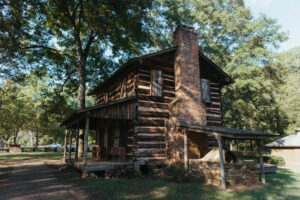Nestled in the rolling hills and pine forests of South Carolina, the Old 96 District, encompassing Abbeville, Edgefield, Greenwood, Laurens and McCormick Counties, offers visitors a unique lens into the South’s complex past. From the American Revolution to the Civil War, this region played pivotal roles in shaping the course of American history, and its deep-rooted stories continue to impact how visitors view key events in the nation’s past. My recent travels through this historic district, particularly Abbeville and the Ninety Six National Historic Site, immersed me in the echoes of those days.
Abbeville: The Birthplace of Secession
Abbeville, known as the “Birthplace and Deathbed of the Confederacy,” is an unassuming town that witnessed two of the Civil War’s most pivotal moments. In November 1860, it was here, in a meeting at Secession Hill, that the first organized discussion about leaving the Union took place. Southern leaders, weary of political compromises, gathered to plot a course that would eventually lead to the secession of South Carolina and, subsequently, the start of the Civil War. Standing on that same hill today, one feels the weight of the decisions made in those historic discussions, decisions that ignited a war whose reverberations still resonate in the American consciousness.
While the seeds of the Confederacy were planted in Abbeville, they also met their demise here. In May 1865, after four brutal years of war, Confederate President Jefferson Davis gathered his remaining cabinet in the Burt-Stark Mansion. Built in the 1830s by lawyer and planter David Lesley, the mansion’s imposing columns and lush grounds offer a glimpse into Southern antebellum life. The house is as much a time capsule as it is a memorial.
Inside, Davis confronted the inevitable – he admitted to his cabinet that the South’s dream of independence had failed. This was the Confederacy’s final meeting, marking the end of a bloody chapter in American history. Walking through the mansion’s rooms, filled with period furnishings and artifacts, I could imagine the tension and resignation of that fateful day. But the Burt-Stark Mansion tells more than just the story of defeat; it’s a window into the everyday lives of Southern aristocracy, showcasing their elegance, wealth, and eventual downfall.
The Ninety Six National Historic Site: A Revolutionary Battlefield
The Old 96 District’s historical significance extends beyond the Civil War – it also played a crucial role during the American Revolution. The Ninety Six National Historic Site, the only National Park Service site in the district, is a hidden gem that brings the Revolutionary War to life in vivid detail. Located in present-day Greenwood County, this site was the scene of intense fighting between Patriots and Loyalists.


At the heart of the site is the remains of Star Fort, where British forces defended a small but strategically vital outpost against the American siege in 1781. As I walked the grounds, I learned how Ninety Six was an essential stronghold for the British in the South, and how it was the focus of a grueling siege led by Major General Nathanael Greene. For 28 days, Greene’s forces attempted to breach the British defenses. Ultimately, the siege was unsuccessful, but it marked one of the longest and most hard-fought engagements of the Revolution.
Standing among the earthen fortifications, it’s easy to appreciate the enormity of what took place here. The peaceful forest surroundings you see now contrast sharply with the bloody battles fought for control over this patch of land. I got a sense of how critical the Southern theater was to the American victory in the war. The park’s visitors center and interpretive trails provide historical context, but it’s the landscape itself – the trenches, the remnants of the fort, and the peaceful waters of the nearby creeks – that really brings the past to life.
Reexamining History through New Eyes
Visiting sites like the Burt-Stark Mansion and the Ninety Six National Historic Site forces one to grapple with the multi-faceted layers of American history. For someone like me, who grew up in the Midwest and spent much of my adult life in the Northeast, these stories of secession and rebellion add complexity to my understanding of the Civil War and Revolutionary War eras. They challenge the narratives I’ve learned and make me appreciate the nuanced ways in which regional history intersects with national identity.
Visiting sites like the Burt-Stark Mansion and the Ninety Six National Historic Site forces one to grapple with the multi-faceted layers of American history. For someone like me, who grew up in the Midwest and spent much of my adult life in the Northeast, these stories of secession and rebellion add complexity to my understanding of the Civil War and Revolutionary War eras. They challenge the narratives I’ve learned and make me appreciate the nuanced ways in which regional history intersects with national identity.


In Abbeville and at Ninety Six, history isn’t just something you read about; it’s something you feel as you walk through the remnants of forts, stand in rooms where decisions were made, and imagine the lives of the people who inhabited this land centuries before.
These experiences gave me a deeper understanding of the region’s profound impact on American history, as well as a reminder that the past is never as distant as it seems. Whether you come for the architecture, the battlefields, or simply to soak in the beauty of the South Carolina countryside, the Old 96 District leaves a lasting impression – one that challenges, enlightens, and invites reflection on the legacies that continue to shape our nation.

Patricia King is a travel writer based in Atlanta, GA. A former reporter for several newspapers and wire services, she also writes about budget and best value travel and North American travel destinations topics. She is the creator of Savvy Traveling, a travel and lifestyle blog for adults over 50, empty nesters, and active baby boomers.






